
Rewilding Britain: Wolf and Bear Reintroduction Sparks Jurassic Park Hopes and Fears
Rewilding Britain: Wolves, Bears, and Lynxes Could Return—But Not Everyone Agrees
For many in the UK, the idea of encountering wolves, bears, or lynxes in the wild sounds like a distant fantasy. Yet, scientists and conservationists are pushing to reintroduce these apex predators to British landscapes, where they once thrived before being hunted to extinction centuries ago. While advocates argue this "rewilding" could restore ecosystems, critics fear risks to livestock, pets, and even people.
The Controversial Proposal
The plan centers on reintroducing grey wolves, brown bears, and Eurasian lynxes to areas like the Scottish Highlands. At Bristol Zoo Project, these species already coexist in large enclosures, offering a glimpse of their potential roles in the wild. However, releasing them into open landscapes remains contentious.
Farmers strongly oppose the idea. Andrew Connon of the National Farmers’ Union Scotland warns it would be an "absolute catastrophe," citing threats to sheep and livelihoods. Wolves and bears could destabilize rural communities, where livestock losses are already a concern. In Norway, for instance, thousands of sheep are killed annually by predators like wolves.

Grey wolves at Bristol Zoo Project, part of a controlled habitat. Critics argue wild reintroduction risks chaos.
Ecological Benefits vs. Social Challenges
Proponents highlight ecological perks. Wolves, for example, could control red deer populations, which damage woodlands by overgrazing saplings. This mirrors Yellowstone National Park’s success, where wolf reintroduction in the 1990s spurred forest regeneration. Similarly, lynxes might manage rodent and deer numbers.
Yet, social acceptance is shaky. Professor Dominick Spracklen (University of Leeds) notes that wolf reintroduction "might never be feasible" due to farmer opposition. Public fears also persist, despite rare instances of wolf attacks on humans in Europe.

Wild wolves in Europe number around 17,000, but their return to Britain divides opinion.
Historical Precedents and Past Efforts
Wolves vanished from Britain by the 18th century, while bears disappeared around 1,000 years ago. Rewilding proposals date back decades. In 2007, Alladale Wilderness Reserve in Scotland aimed to mimic Yellowstone by reintroducing wolves and bears. Though the idea stalled, the reserve now supports lynx reintroduction studies.

Alladale Wilderness Reserve, once a candidate for wolf reintroduction, now focuses on lynx restoration.
Balancing Risks and Rewards
Safety concerns linger. While European wolves rarely attack humans (no fatal incidents in 40 years), brown bears—though less aggressive than grizzlies—have caused fatalities in countries like Romania. Lynxes, solitary hunters, pose minimal human risk but could prey on sheep.
The Wildlife Trusts stress that reintroductions require rigorous public consultation. Rob Stoneman highlights the success of England’s beaver reintroduction, which gained local backing. "Nature recovery must involve communities directly affected," he says.
The Path Ahead
Bristol Zoo’s Brian Zimmerman emphasizes that even captive wolves and bears remain wild at heart. "They avoid humans unless threatened," he notes. For now, UK rewilding efforts focus on less contentious species, like beavers, while debates over predators continue.

A lynx at Bristol Zoo: Rewilding advocates see potential, but challenges remain.
As Britain grapples with biodiversity loss, the question isn’t just about ecological feasibility—it’s about whether society will embrace sharing landscapes with its long-lost predators.


